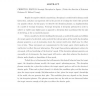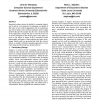611 search results - page 118 / 123 » Using GP to Model Contextual Human Behavior |
BMCBI
2004
13 years 7 months ago
2004
Background: Modern biological research makes possible the comprehensive study and development of heritable mutations in the mouse model at high-throughput. Using techniques spanni...
ATAL
2004
Springer
14 years 1 months ago
2004
Springer
CHRISTIAN, DAVID B. Strategic Deception in Agents. (Under the direction of Assistant Professor R. Michael Young). Despite its negative ethical connotations, deception is a useful ...
ICRA
2005
IEEE
14 years 1 months ago
2005
IEEE
— Imitation is a powerful mechanism for transferring knowledge from an instructor to a na¨ıve observer, one that is deeply contingent on a state of shared attention between the...
SIGCSE
2002
ACM
13 years 7 months ago
2002
ACM
Empirical evidence shows the ability for computer technology to deliver on its promises of enhancing our quality of life relies on how well the application fits our understanding ...
ICANN
2010
Springer
13 years 6 months ago
2010
Springer
Trajectory formation is one of the basic functions of the neuromotor controller. In particular, reaching, avoiding, controlling impacts (hitting), drawing, dancing and imitating ar...


